 |
Ground Water and Surface Water A Single Resource--USGS Circular 1139
The hydrologic cycle describes the continuous movement of water above, on, and below the surface of the Earth. The water on the Earth's surface--surface water--occurs as streams, lakes, and wetlands, as well as bays and oceans. Surface water also includes the solid forms of water-- snow and ice. The water below the surface of the Earth primarily is ground water, but it also includes soil water.
The hydrologic cycle commonly is portrayed by a very simplified diagram that shows only major transfers of water between continents and oceans, as in Figure 1. However, for understanding hydrologic processes and managing water resources, the hydrologic cycle needs to be viewed at a wide range of scales and as having a great deal of variability in time and space. Precipitation, which is the source of virtually all freshwater in the hydrologic cycle, falls nearly everywhere, but its distribution is highly variable. Similarly, evaporation and transpiration return water to the atmosphere nearly everywhere, but evaporation and transpiration rates vary considerably according to climatic conditions. As a result, much of the precipitation never reaches the oceans as surface and subsurface runoff before the water is returned to the atmosphere. The relative magnitudes of the individual components of the hydrologic cycle, such as evapotranspiration, may differ significantly even at small scales, as between an agricultural field and a nearby woodland.
 |
Figure 1. Ground water is the second smallest of the four main pools of water on Earth, and river flow to the oceans is one of the smallest fluxes, yet ground water and surface water are the components of the hydrologic system that humans use most. (Modified from Schelesinger, W.H., 1991, Biogeochemistry-An analysis of global change: Academic Press, San Diego, California.) (Used with permission.)
To present the concepts and many facets of the interaction of ground water and surface water in a unified way, a conceptual landscape is used (Figure 2). The conceptual landscape shows in a very general and simplified way the interaction of ground water with all types of surface water, such as streams, lakes, and wetlands, in many different terrains from the mountains to the oceans. The intent of Figure 2 is to emphasize that ground water and surface water interact at many places throughout the landscape.
|
|
 |
Figure 2. Ground water and surface water interact throughout all landscapes from the mountains to the oceans, as depicted in this diagram of a conceptual landscape. M, mountainous; K, karst; G, glacial; R, riverine (small); V, riverine (large); C, coastal.
Haze over Appalachian Mountains in North Carolina. (Photograph courtesy of North Carolina Department of Travel and Tourism.)
Movement of water in the atmosphere and on the land surface is relatively easy to visualize, but the movement of ground water is not. Concepts related to ground water and the movement of ground water are introduced in Box A. As illustrated in Figure 3, ground water moves along flow paths of varying lengths from areas of recharge to areas of discharge. The generalized flow paths in Figure 3 start at the water table, continue through the ground-water system, and terminate at the stream or at the pumped well. The source of water to the water table (ground-water recharge) is infiltration of precipitation through the unsaturated zone. In the uppermost, unconfined aquifer, flow paths near the stream can be tens to hundreds of feet in length and have corresponding traveltimes of days to a few years. The longest and deepest flow paths in Figure 3 may be thousands of feet to tens of miles in length, and traveltimes may range from decades to millennia. In general, shallow ground water is more susceptible to contamination from human sources and activities because of its close proximity to the land surface. Therefore, shallow, local patterns of ground-water flow near surface water are emphasized in this Circular.
Ground water moves along flow paths of varying lengths in transmitting water from areas of recharge to areas of discharge"
Small-scale geologic features in beds of surface-water bodies affect seepage patterns at scales too small to be shown in Figure 3. For example, the size, shape, and orientation of the sediment grains in surface-water beds affect seepage patterns. If a surface-water bed consists of one sediment type, such as sand, inflow seepage is greatest at the shoreline, and it decreases in a nonlinear pattern away from the shoreline (Figure 4). Geologic units having different permeabilities also affect seepage distribution in surface-water beds. For example, a highly permeable sand layer within a surface-water bed consisting largely of silt will transmit water preferentially into the surface water as a spring (Figure 5).
Subaqueous spring in Nebraska. (Photograph by Charels Flowerday.)
 |
Figure 3. Ground-water flow paths vary greatly in length, depth, and traveltime from points of recharge to points of discharge in the ground-water system.
 |
Figure 4. Ground-water seepage into surface water usually is greatest near shore. In flow diagrams such as that shown here, the quantity of discharge is equal between any two flow lines; therefore, the closer flow lines indicate greater discharge per unit of bottom area.
 |
Figure 5. Subaqueous springs can result from preferred paths of ground-water flow through highly permeable sediments.
Changing meteorological conditions also strongly affect seepage patterns in surface-water beds, especially near the shoreline. The water table commonly intersects land surface at the shoreline, resulting in no unsaturated zone at this point. Infiltrating precipitation passes rapidly through a thin unsaturated zone adjacent to the shoreline, which causes water-table mounds to form quickly adjacent to the surface water (Figure 6). This process, termed focused recharge, can result in increased ground-water inflow to surface-water bodies, or it can cause inflow to surface-water bodies that normally have seepage to ground water. Each precipitation event has the potential to cause this highly transient flow condition near shorelines as well as at depressions in uplands (Figure 6).
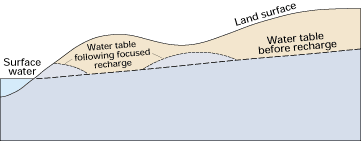 |
Figure 6. Ground-water recharge commonly is focused initially where the unsaturated zone is relatively thin at the edges of surface-water bodies and beneath depressions in the land surface.
Transpiration by nearshore plants has the opposite effect of focused recharge. Again, because the water table is near land surface at edges of surface-water bodies, plant roots can penetrate into the saturated zone, allowing the plants to transpire water directly from the ground-water system (Figure 7). Transpiration of ground water commonly results in a drawdown of the water table much like the effect of a pumped well. This highly variable daily and seasonal transpiration of ground water may significantly reduce ground-water discharge to a surface-water body or even cause movement of surface water into the subsurface. In many places it is possible to measure diurnal changes in the direction of flow during seasons of active plant growth; that is, ground water moves into the surface water during the night, and surface water moves into shallow ground water during the day.
 |
Figure 7. Where the depth to the water table is small adjacent to surface-water bodies, transpiration directly from ground water can cause cones of depression similar to those caused by pumping wells. This sometimes draws water directly from the surface water into the subsurface.
These periodic changes in the direction of flow also take place on longer time scales: focused recharge from precipitation predominates during wet periods and drawdown by transpiration predominates during dry periods. As a result, the two processes, together with the geologic controls on seepage distribution, can cause flow conditions at the edges of surface-water bodies to be extremely variable. These "edge effects" probably affect small surface-water bodies more than large surface-water bodies because the ratio of edge length to total volume is greater for small water bodies than it is for large ones.
Phreatophytes along the Rio Grande in Texas. (Photograph by Michael Collier.)
Streams interact with ground water in all types of landscapes (see Box B). The interaction takes place in three basic ways: streams gain water from inflow of ground water through the streambed (gaining stream, Figure 8A), they lose water to ground water by outflow through the streambed (losing stream, Figure 9A), or they do both, gaining in some reaches and losing in other reaches. For ground water to discharge into a stream channel, the altitude of the water table in the vicinity of the stream must be higher than the altitude of the stream-water surface. Conversely, for surface water to seep to ground water, the altitude of the water table in the vicinity of the stream must be lower than the altitude of the stream-water surface. Contours of water-table elevation indicate gaining streams by pointing in an upstream direction (Figure 8B), and they indicate losing streams by pointing in a downstream direction (Figure 9B) in the immediate vicinity of the stream.
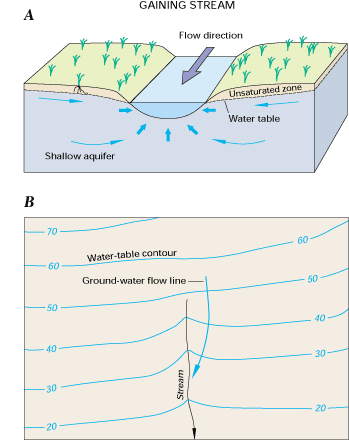 |
Figure 8. Gaining streams receive water from the ground-water system (A). This can be determined from water-table contour maps because the contour lines point in the upstream direction where they cross the stream (B).
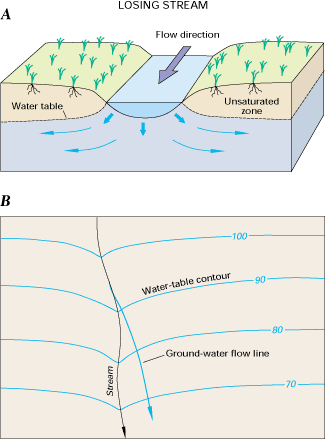 |
Figure 9. Losing streams lose water to the ground-water system (A). This can be determined from water-table contour maps because the contour lines point in the downstream direction where they cross the stream (B).
Losing streams can be connected to the ground-water system by a continuous saturated zone (Figure 9A) or can be disconnected from the ground-water system by an unsaturated zone. Where the stream is disconnected from the ground-water system by an unsaturated zone, the water table may have a discernible mound below the stream (Figure 10) if the rate of recharge through the streambed and unsaturated zone is greater than the rate of lateral ground-water flow away from the water-table mound. An important feature of streams that are disconnected from ground water is that pumping of shallow ground water near the stream does not affect the flow of the stream near the pumped wells.
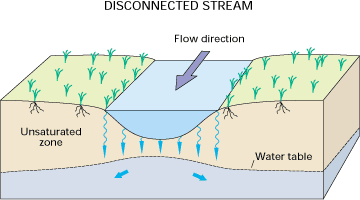 |
Figure 10. Disconnected streams are separated from the ground-water system by an unsaturated zone.
In some environments, streamflow gain or loss can persist; that is, a stream might always gain water from ground water, or it might always lose water to ground water. However, in other environments, flow direction can vary a great deal along a stream; some reaches receive ground water, and other reaches lose water to ground water. Furthermore, flow direction can change in very short timeframes as a result of individual storms causing focused recharge near the streambank, temporary flood peaks moving down the channel, or transpiration of ground water by streamside vegetation.
A type of interaction between ground water and streams that takes place in nearly all streams at one time or another is a rapid rise in stream stage that causes water to move from the stream into the streambanks. This process, termed bank storage (Figures 11 and 12B), usually is caused by storm precipitation, rapid snowmelt, or release of water from a reservoir upstream. As long as the rise in stage does not overtop the streambanks, most of the volume of stream water that enters the streambanks returns to the stream within a few days or weeks. The loss of stream water to bank storage and return of this water to the stream in a period of days or weeks tends to reduce flood peaks and later supplement stream flows. If the rise in stream stage is sufficient to overtop the banks and flood large areas of the land surface, widespread recharge to the water table can take place throughout the flooded area (Figure 12C). In this case, the time it takes for the recharged floodwater to return to the stream by ground-water flow may be weeks, months, or years because the lengths of the ground-water flow paths are much longer than those resulting from local bank storage. Depending on the frequency, magnitude, and intensity of storms and on the related magnitude of increases in stream stage, some streams and adjacent shallow aquifers may be in a continuous readjustment from interactions related to bank storage and overbank flooding.
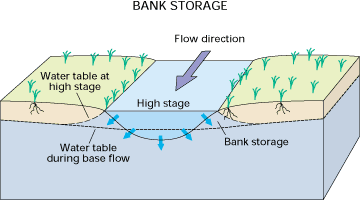 |
Figure 11. If stream levels rise higher than adjacent ground-water levels, stream water moves into the streambanks as bank storage.
Streams interact with ground water in three basic ways: streams gain water from inflow of ground water through the streambed (gaining stream), they lose water to ground water by outflow through the streambed (losing stream), or they do both, gaining in some reaches and losing in other reaches"
|
|
Figure 12. If stream levels rise higher than their streambanks (C), the floodwaters recharge ground water throughout the flooded areas.
In addition to bank storage, other processes may affect the local exchange of water between streams and adjacent shallow aquifers. Changes in streamflow between gaining and losing conditions can also be caused by pumping ground water near streams (see Box C). Pumping can intercept ground water that would otherwise have discharged to a gaining stream, or at higher pumping rates it can induce flow from the stream to the aquifer.
Flooding at the confluence of the Missouri and Mississippi Rivers. (Photograph by Robert Meade.)
Where streamflow is generated in head-waters areas, the changes in streamflow between gaining and losing conditions may be particularly variable (Figure 13). The headwaters segment of streams can be completely dry except during storm events or during certain seasons of the year when snowmelt or precipitation is sufficient to maintain continuous flow for days or weeks. During these times, the stream will lose water to the unsaturated zone beneath its bed. However, as the water table rises through recharge in the headwaters area, the losing reach may become a gaining reach as the water table rises above the level of the stream. Under these conditions, the point where ground water first contributes to the stream gradually moves upstream.
 |
Figure 13. The location where perennial streamflow begins in a channel can vary depending on the distribution of recharge in headwaters areas. Following dry periods (A), the start of streamflow will move up-channel during wet periods as the ground-water system becomes more saturated (B).
Some gaining streams have reaches that lose water to the aquifer under normal conditions of streamflow. The direction of seepage through the bed of these streams commonly is related to abrupt changes in the slope of the streambed (Figure 14A) or to meanders in the stream channel (Figure 14B). For example, a losing stream reach usually is located at the downstream end of pools in pool and riffle streams (Figure 14A), or upstream from channel bends in meandering streams (Figure 14B). The subsurface zone where stream water flows through short segments of its adjacent bed and banks is referred to as the hyporheic zone. The size and geometry of hyporheic zones surrounding streams vary greatly in time and space. Because of mixing between ground water and surface water in the hyporheic zone, the chemical and biological character of the hyporheic zone may differ markedly from adjacent surface water and ground water.
 |
Figure 14. Surface-water exchange with ground water in the hyporheic zone is associated with abrupt changes in streambed slope (A) and with stream meanders (B).
Pool and riffle stream in Colorado. (Photograph by Robert Broshears.)
Ground-water systems that discharge to streams can underlie extensive areas of the land surface (Figure 15). As a result, environmental conditions at the interface between ground water and surface water reflect changes in the broader landscape. For example, the types and numbers of organisms in a given reach of streambed result, in part, from interactions between water in the hyporheic zone and ground water from distant sources.
 |
Figure 15. Streambeds and banks are unique environments because they are where ground water that drains much of the subsurface of landscapes interacts with surface water that drains much of the surface of landscapes.
Lakes interact with ground water in three basic ways: some receive ground-water inflow throughout their entire bed; some have seepage loss to ground water throughout their entire bed; but perhaps most lakes receive ground-water inflow through part of their bed and have seepage loss to ground water through other parts (Figure 16). Although these basic interactions are the same for lakes as they are for streams, the interactions differ in several ways.
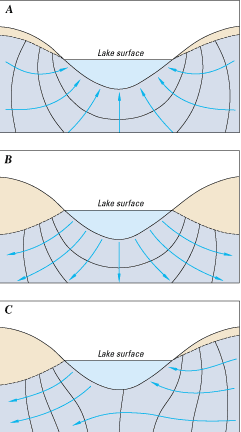 |
|---|
Figure 16. Lakes can receive ground-water inflow (A), lose water as seepage to ground water (B), or both (C).
The water level of natural lakes, that is, those not controlled by dams, generally does not change as rapidly as the water level of streams; therefore, bank storage is of lesser importance in lakes than it is in streams. Evaporation generally has a greater effect on lake levels than on stream levels because the surface area of lakes is generally larger and less shaded than many reaches of streams, and because lake water is not replenished as readily as a reach of a stream. Lakes can be present in many different parts of the landscape and can have complex ground-water flow systems associated with them. This is especially true for lakes in glacial and dune terrain, as is discussed in a later section of this Circular. Furthermore, lake sediments commonly have greater volumes of organic deposits than streams. These poorly permeable organic deposits can affect the distribution of seepage and biogeochemical exchanges of water and solutes more in lakes than in streams.
Lake country in northern Wisconsin. (Photograph by David Krabbenhoft.)
Reservoirs are human-made lakes that are designed primarily to control the flow and distribution of surface water. Most reservoirs are constructed in stream valleys; therefore, they have some characteristics both of streams and lakes. Like streams, reservoirs can have widely fluctuating levels, bank storage can be significant, and they commonly have a continuous flushing of water through them. Like lakes, reservoirs can have significant loss of water by evaporation, significant cycling of chemical and biological materials within their waters, and extensive biogeochemical exchanges of solutes with organic sediments.
"Lakes and wetlands can receive ground-water inflow throughout their entire bed, have outflow throughout their entire bed, or have both inflow and outflow at different localities"
Wetlands are present in climates and landscapes that cause ground water to discharge to land surface or that prevent rapid drainage of water from the land surface. Similar to streams and lakes, wetlands can receive ground-water inflow, recharge ground water, or do both. Those wetlands that occupy depressions in the land surface have interactions with ground water similar to lakes and streams. Unlike streams and lakes, however, wetlands do not always occupy low points and depressions in the landscape (Figure 17A); they also can be present on slopes (such as fens) or even on drainage divides (such as some types of bogs). Fens are wetlands that commonly receive ground-water discharge (Figure 17B); therefore, they receive a continuous supply of chemical constituents dissolved in the ground water. Bogs are wetlands that occupy uplands (Figure 17D) or extensive flat areas, and they receive much of their water and chemical constituents from precipitation. The distribution of major wetland areas in the United States is shown in Figure 18.
Upland bog Labrador, Canada. (Photograph by Lehn Franke.)
In areas of steep land slopes, the water table sometimes intersects the land surface, resulting in ground-water discharge directly to the land surface. The constant source of water at these seepage faces (Figure 17B) permits the growth of wetland plants. A constant source of ground water to wetland plants is also provided to parts of the landscape that are downgradient from breaks in slope of the water table (Figure 17B), and where subsurface discontinuities in geologic units cause upward movement of ground water (Figure 17A). Many wetlands are present along streams, especially slow-moving streams. Although these riverine wetlands (Figure 17C) commonly receive ground-water discharge, they are dependent primarily on the stream for their water supply.
 |
Figure 17. The source of water to wetlands can be from ground-water discharge where the land surface is underlain by complex ground-water flow fields (A), from ground-water discharge at seepage faces and at breaks in slope of the water table (B), from streams (C), and from precipitation in cases where wetlands have no stream inflow and ground-water gradients slope away from the wetland (D).
 |
Figure 18. Wetlands are present throughout the Nation, but they cover the largest areas in the glacial terrain of the north-central United States, coastal terrain along the Atlantic and gulf coasts, and riverine terrain in the lower Mississippi River Valley.
Wetlands in riverine and coastal areas have especially complex hydrological interactions because they are subject to periodic water-level changes. Some wetlands in coastal areas are affected by very predictable tidal cycles. Other coastal wetlands and riverine wetlands are more affected by seasonal water-level changes and by flooding. The combined effects of precipitation, evapotranspiration, and interaction with surface water and ground water result in a pattern of water depths in wetlands that is distinctive.
Hydroperiod is a term commonly used in wetland science that refers to the amplitude and frequency of water-level fluctuations. Hydroperiod affects all wetland characteristics, including the type of vegetation, nutrient cycling, and the types of invertebrates, fish, and bird species present.
Seepage face in Zion National Park, Utah. (Photograph by Robert Shedlock.)
A major difference between lakes and wetlands, with respect to their interaction with ground water, is the ease with which water moves through their beds. Lakes commonly are shallow around their perimeter where waves can remove fine-grained sediments, permitting the surface water and ground water to interact freely. In wetlands, on the other hand, if fine-grained and highly decomposed organic sediments are present near the wetland edge, the transfer of water and solutes between ground water and surface water is likely to be much slower.
Another difference in the interaction between ground water and surface water in wetlands compared to lakes is determined by rooted vegetation in wetlands. The fibrous root mat in wetland soils is highly conductive to water flow; therefore, water uptake by roots of emergent plants results in significant interchange between surface water and pore water of wetland sediments. The water exchanges in this upper soil zone even if exchange between surface water and ground water is restricted at the base of the wetland sediments.
Two of the fundamental controls on water chemistry in drainage basins are the type of geologic materials that are present and the length of time that water is in contact with those materials. Chemical reactions that affect the biological and geochemical characteristics of a basin include (1) acid-base reactions, (2) precipitation and dissolution of minerals, (3) sorption and ion exchange, (4) oxidation-reduction reactions, (5) biodegradation, and (6) dissolution and exsolution of gases (see Box D). When water first infiltrates the land surface, microorganisms in the soil have a significant effect on the evolution of water chemistry. Organic matter in soils is degraded by microbes, producing high concentrations of dissolved carbon dioxide (CO2). This process lowers the pH by increasing the carbonic acid (H2CO3) concentration in the soil water. The production of carbonic acid starts a number of mineral-weathering reactions, which result in bicarbonate (HCO3-) commonly being the most abundant anion in the water. Where contact times between water and minerals in shallow ground-water flow paths are short, the dissolved-solids concentration in the water generally is low. In such settings, limited chemical changes take place before ground water is discharged to surface water.
"Two of the fundamental controls on water chemistry in drainage basins are the type of geologic materials that are present and the length of time that water is in contact with those materials"
In deeper ground-water flow systems, the contact time between water and minerals is much longer than it is in shallow flow systems. As a result, the initial importance of reactions relating to microbes in the soil zone may be superseded over time by chemical reactions between minerals and water (geochemical weathering). As weathering progresses, the concentration of dissolved solids increases. Depending on the chemical composition of the minerals that are weathered, the relative abundance of the major inorganic chemicals dissolved in the water changes (see Box E).
Surface water in streams, lakes, and wetlands can repeatedly interchange with nearby ground water. Thus, the length of time water is in contact with mineral surfaces in its drainage basin can continue after the water first enters a stream, lake, or wetland. An important consequence of these continued interchanges between surface water and ground water is their potential to further increase the contact time between water and chemically reactive geologic materials.
Ground-water chemistry and surface-water chemistry cannot be dealt with separately where surface and subsurface flow systems interact. The movement of water between ground water and surface water provides a major pathway for chemical transfer between terrestrial and aquatic systems (see Box F). This transfer of chemicals affects the supply of carbon, oxygen, nutrients such as nitrogen and phosphorus, and other chemical constituents that enhance biogeochemical processes on both sides of the interface. This transfer can ultimately affect the biological and chemical characteristics of aquatic systems downstream.
"The movement of water between ground water and surface water provides a major pathway for chemical transfer between terrestrial and aquatic systems"
Many streams are contaminated. Therefore, the need to determine the extent of the chemical reactions that take place in the hyporheic zone is widespread because of the concern that the contaminated stream water will contaminate shallow ground water (see Box G). Streams offer good examples of how interconnections between ground water and surface water affect chemical processes. Rough channel bottoms cause stream water to enter the streambed and to mix with ground water in the hyporheic zone. This mixing establishes sharp changes in chemical concentrations in the hyporheic zone.A zone of enhanced biogeochemical activity usually develops in shallow ground water as a result of the flow of oxygen-rich surface water into the subsurface environment, where bacteria and geochemically active sediment coatings are abundant (Figure 19). This input of oxygen to the streambed stimulates a high level of activity by aerobic (oxygen-using) microorganisms if dissolved oxygen is readily available. It is not uncommon for dissolved oxygen to be completely used up in hyporheic flow paths at some distance into the streambed, where anaerobic microorganisms dominate microbial activity. Anaerobic bacteria can use nitrate, sulfate, or other solutes in place of oxygen for metabolism. The result of these processes is that many solutes are highly reactive in shallow ground water in the vicinity of streambeds.
 |
Figure 19. Microbial activity and chemical transformations commonly are enhanced in the hyporheic zone compared to those that take place in ground water and surface water. This diagram illustrates some of the processes and chemical transformations that may take place in the hyporheic zone. Actual chemical interactions depend on numerous factors including aquifer mineralogy, shape of the aquifer, types of organic matter in surface water and ground water, and nearby land use.
The movement of nutrients and other chemical constituents, including contaminants, between ground water and surface water is affected by biogeochemical processes in the hyporheic zone. For example, the rate at which organic contaminants biodegrade in the hyporheic zone can exceed rates in stream water or in ground water away from the stream. Another example is the removal of dissolved metals in the hyporheic zone. As water passes through the hyporheic zone, dissolved metals are removed by precipitation of metal oxide coatings on the sediments.
Lakes and wetlands also have distinctive biogeochemical characteristics with respect to their interaction with ground water. The chemistry of ground water and the direction and magnitude of exchange with surface water significantly affect the input of dissolved chemicals to lakes and wetlands. In general, if lakes and wetlands have little interaction with streams or with ground water, input of dissolved chemicals is mostly from precipitation; therefore, the input of chemicals is minimal. Lakes and wetlands that have a considerable amount of ground-water inflow generally have large inputs of dissolved chemicals. In cases where the input of dissolved nutrients such as phosphorus and nitrogen exceeds the output, primary production by algae and wetland plants is large. When this large amount of plant material dies, oxygen is used in the process of decomposition. In some cases the loss of oxygen from lake water can be large enough to kill fish and other aquatic organisms.
The magnitude of surface-water inflow and outflow also affects the retention of nutrients in wetlands. If lakes or wetlands have no stream outflow, retention of chemicals is high. The tendency to retain nutrients usually is less in wetlands that are flushed substantially by throughflow of surface water. In general, as surface-water inputs increase, wetlands vary from those that strongly retain nutrients to those that both import and export large amounts of nutrients. Furthermore, wetlands commonly have a significant role in altering the chemical form of dissolved constituents. For example, wetlands that have throughflow of surface water tend to retain the chemically oxidized forms and release the chemically reduced forms of metals and nutrients.
Eutrophic lake in Saskatchewan, Canada. (Photograph by James LaBaugh.)
"The chemistry of ground water and the direction and magnitude of exchange with surface water significantly affect the input of dissolved chemicals to lakes and wetlands"
Ground water is present in virtually all landscapes. The interaction of ground water with surface water depends on the physiographic and climatic setting of the landscape. For example, a stream in a wet climate might receive ground-water inflow, but a stream in an identical physiographic setting in an arid climate might lose water to ground water. To provide a broad and unified perspective of the interaction of ground water and surface water in different landscapes, a conceptual landscape (Figure 2) is used as a reference. Some common features of the interaction for various parts of the conceptual landscape are described below. The five general types of terrain discussed are mountainous, riverine, coastal, glacial and dune, and karst.
The hydrology of mountainous terrain (area M of the conceptual landscape, Figure 2) is characterized by highly variable precipitation and water movement over and through steep land slopes. On mountain slopes, macropores created by burrowing organisms and by decay of plant roots have the capacity to transmit subsurface flow downslope quickly. In addition, some rock types underlying soils may be highly weathered or fractured and may transmit significant additional amounts of flow through the subsurface. In some settings this rapid flow of water results in hillside springs.
 |
A general concept of water flow in mountainous terrain includes several pathways by which precipitation moves through the hillside to a stream (Figure 20). Between storm and snowmelt periods, streamflow is sustained by discharge from the ground-water system (Figure 20A). During intense storms, most water reaches streams very rapidly by partially saturating and flowing through the highly conductive soils. On the lower parts of hillslopes, the water table sometimes rises to the land surface during storms, resulting in overland flow (Figure 20B). When this occurs, precipitation on the saturated area adds to the quantity of overland flow. When storms or snowmelt persist in mountainous areas, near-stream saturated areas can expand outward from streams to include areas higher on the hillslope. In some settings, especially in arid regions, overland flow can be generated when the rate of rainfall exceeds the infiltration capacity of the soil (Figure 20C).
 |
Figure 20. Water from precipitation moves to mountain streams along several pathways. Between storms and snowmelt periods, most inflow to streams commonly is from ground water (A). During storms and snowmelt periods, much of the water inflow to streams is from shallow flow in saturated macropores in the soil zone. If infiltration to the water table is large enough, the water table will rise to the land surface and flow to the stream is from ground water, soil water, and overland runoff (B). In arid areas where soils are very dry and plants are sparse, infiltration is impeded and runoff from precipitation can occur as overland flow (C). (Modified from Dunne, T., and Leopold, L.B., 1978, Water in environmental planning: San Francisco, W.H. Freeman.) (Used with permission.)
Near the base of some mountainsides, the water table intersects the steep valley wall some distance up from the base of the slope (Figure 21, left side of valley). This results in perennial discharge of ground water and, in many cases, the presence of wetlands. A more common hydrologic process that results in the presence of wetlands in some mountain valleys is the upward discharge of ground water caused by the change in slope of the water table from being steep on the valley side to being relatively flat in the alluvial valley (Figure 21, right side of valley). Where both of these water-table conditions exist, wetlands fed by ground water, which commonly are referred to as fens, can be present.
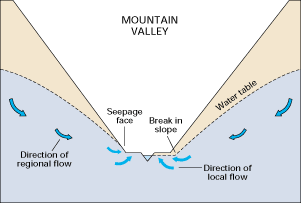 |
Figure 21. In mountainous terrain, ground water can discharge at the base of steep slopes (left side of valley), at the edges of flood plains (right side of valley), and to the stream.
Another dynamic aspect of the interaction of ground water and surface water in mountain settings is caused by the marked longitudinal component of flow in mountain valleys. The high gradient of mountain streams, coupled with the coarse texture of streambed sediments, results in a strong down-valley component of flow accompanied by frequent exchange of stream water with water in the hyporheic zone (Figure 14) (see Box H). The driving force for water exchange between a stream and its hyporheic zone is created by the surface water flowing over rough streambeds, through pools and riffles, over cascades, and around boulders and logs. Typically, the stream enters the hyporheic zone at the downstream end of pools and then flows beneath steep sections of the stream (called riffles), returning to the stream at the upstream end of the next pool (Figure 14A). Stream water also may enter the hyporheic zone upstream from channel meanders, causing stream water to flow through a gravel bar before reentering the channel downstream (Figure 14B).
Mountain stream in Oregon. (Photograph by Dennis Wentz.)
Alluvial fan in Alaska. (Photograph by Earl Brabb.)
Streams flowing from mountainous terrain commonly flow across alluvial fans at the edges of the valleys. Most streams in this type of setting lose water to ground water as they traverse the highly permeable alluvial fans. This process has long been recognized in arid western regions, but it also has been documented in humid regions, such as the Appalachian Mountains. In arid and semiarid regions, seepage of water from the stream can be the principal source of aquifer recharge. Despite its importance, ground-water recharge from losing streams remains a highly uncertain part of the water balance of aquifers in these regions. Promising new methods of estimating ground-water recharge, at least locally, along mountain fronts are being developed-these methods include use of environmental tracers, measuring vertical temperature profiles in streambeds, measuring hydraulic characteristics of streambeds, and measuring the difference in hydraulic head between the stream and the underlying aquifer.
The most common natural lakes in mountainous terrain are those that are dammed by rock sills or glacial deposits high in the mountains. Termed cirque lakes, they receive much of their water from snowmelt. However, they interact with ground water much like the processes shown in Figure 21, and they can be maintained by ground water throughout the snow-free season.
The geochemical environment of mountains is quite diverse because of the effects of highly variable climate and many different rock and soil types on the evolution of water chemistry. Geologic materials can include crystalline, volcanic, and sedimentary rocks and glacial deposits. Sediments can vary from those having well-developed soil horizons to stream alluvium that has no soil development. During heavy precipitation, much water flows through shallow flow paths, where it interacts with microbes and soil gases. In the deeper flow through fractured bedrock, longer term geochemical interactions of ground water with minerals determine the chemistry of water that eventually discharges to streams. Base flow of streams in mountainous terrain is derived by drainage from saturated alluvium in valley bottoms and from drainage of bedrock fractures. Mixing of these chemically different water types results in geochemical reactions that affect the chemistry of water in streams. During downstream transport in the channel, stream water mixes with ground water in the hyporheic zone. In some mountain streams, the volume of water in the hyporheic zone is considerably larger than that in the stream channel. Chemical reactions in hyporheic zones can, in some cases, substantially alter the water chemistry of streams (Figure 19).
In some landscapes, stream valleys are small and they commonly do not have well-developed flood plains (area R of the conceptual landscape, Figure 2) (see Box I). However, major rivers (area V of the reference landscape, Figure 2) have valleys that usually become increasingly wider downstream. Terraces, natural levees, and abandoned river meanders are common landscape features in major river valleys, and wetlands and lakes commonly are associated with these features.
The interaction of ground water and surface water in river valleys is affected by the interchange of local and regional ground-water flow systems with the rivers and by flooding and evapotranspiration. Small streams receive ground-water inflow primarily from local flow systems, which usually have limited extent and are highly variable seasonally. Therefore, it is not unusual for small streams to have gaining or losing reaches that change seasonally.
Alluvial valley of the Mississippi River. (Photograph by Robert Meade.)
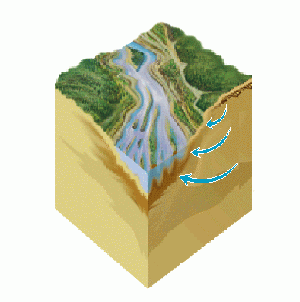 |
For larger rivers that flow in alluvial valleys, the interaction of ground water and surface water usually is more spatially diverse than it is for smaller streams. Ground water from regional flow systems discharges to the river as well as at various places across the flood plain (Figure 22). If terraces are present in the alluvial valley, local ground-water flow systems may be associated with each terrace, and lakes and wetlands may be formed because of this source of ground water. At some locations, such as at the valley wall and at the river, local and regional ground-water flow systems may discharge in close proximity. Furthermore, in large alluvial valleys, significant down-valley components of flow in the streambed and in the shallow alluvium also may be present (see Box I).
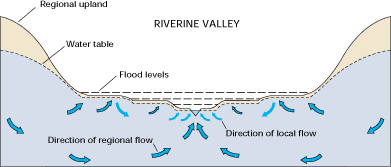 |
Figure 22. In broad river valleys, small local ground-water flow systems associated with terraces overlie more regional ground-water flow systems. Recharge from flood waters superimposed on these ground-water flow systems further complicates the hydrology of river valleys.
Added to this distribution of ground-water discharge from different flow systems to different parts of the valley is the effect of flooding. At times of high river flows, water moves into the ground-water system as bank storage (Figure 11). The flow paths can be as lateral flow through the riverbank (Figure 12B) or, during flooding, as vertical seepage over the flood plain (Figure 12C). As flood waters rise, they cause bank storage to move into higher and higher terraces.
The water table generally is not far below the land surface in alluvial valleys. Therefore, vegetation on flood plains, as well as at the base of some terraces, commonly has root systems deep enough so that the plants can transpire water directly from ground water. Because of the relatively stable source of ground water, particularly in areas of ground-water discharge, the vegetation can transpire water near the maximum potential transpiration rate, resulting in the same effect as if the water were being pumped by a well (see Figure 7). This large loss of water can result in drawdown of the water table such that the plants intercept some of the water that would otherwise flow to the river, wetland, or lake. Furthermore, in some settings it is not uncommon during the growing season for the pumping effect of transpiration to be significant enough that surface water moves into the subsurface to replenish the transpired ground water.
Riverine alluvial deposits range in size from clay to boulders, but in many alluvial valleys, sand and gravel are the predominant deposits. Chemical reactions involving dissolution or precipitation of minerals (see Box D) commonly do not have a significant effect on water chemistry in sand and gravel alluvial aquifers because the rate of water movement is relatively fast compared to weathering rates. Instead, sorption and desorption reactions and oxidation/reduction reactions related to the activity of microorganisms probably have a greater effect on water chemistry in these systems. As in small streams, biogeochemical processes in the hyporheic zone may have a significant effect on the chemistry of ground water and surface water in larger riverine systems. Movement of oxygen-rich surface water into the subsurface, where chemically reactive sediment coatings are abundant, causes increased chemical reactions related to activity of microorganisms. Sharp gradients in concentration of some chemical constituents in water, which delimit this zone of increased biogeochemical activity, are common near the boundary between ground water and surface water. In addition, chemical reactions in the hyporheic zone can cause precipitation of some reactive solutes and contaminants, thereby affecting water quality.
Coastal terrain, such as that along the east-central and southern coasts of the United States, extends from inland scarps and terraces to the ocean (area C of the conceptual landscape, Figure 2). This terrain is characterized by (1) low scarps and terraces that were formed when the ocean was higher than at present; (2) streams, estuaries, and lagoons that are affected by tides; (3) ponds that are commonly associated with coastal sand dunes; and (4) barrier islands. Wetlands cover extensive areas in some coastal terrains (see Figure 18).
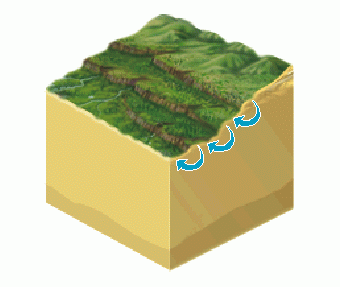 |
The interaction of ground water and surface water in coastal terrain is affected by discharge of ground water from regional flow systems and from local flow systems associated with scarps and terraces (Figure 23), evapotranspiration, and tidal flooding. The local flow systems associated with scarps and terraces are caused by the configuration of the water table near these features (see Box J). Where the water table has a downward break in slope near the top of scarps and terraces, downward components of ground-water flow are present; where the water table has an upward break in slope near the base of these features, upward components of ground-water flow are present.
 |
Figure 23. In coastal terrain, small local ground-water flow cells associated with terraces overlie more regional ground-water flow systems. In the tidal zone, saline and brackish surface water mixes with fresh ground water from local and regional flow systems.
Evapotranspiration directly from ground water is widespread in coastal terrain. The land surface is flat and the water table generally is close to land surface; therefore, many plants have root systems deep enough to transpire ground water at nearly the maximum potential rate. The result is that evapotranspiration causes a significant water loss, which affects the configuration of ground-water flow systems as well as how ground water interacts with surface water.
Coastal terrain in Maryland. (Photograph by Robert Shedlock.)
In the parts of coastal landscapes that are affected by tidal flooding, the interaction of ground water and surface water is similar to that in alluvial valleys affected by flooding. The principal difference between the two is that tidal flooding is more predictable in both timing and magnitude than river flooding. The other significant difference is in water chemistry. The water that moves into bank storage from rivers is generally fresh, but the water that moves into bank storage from tides generally is brackish or saline.
Tidal mangrove wetland in Florida. (Photograph by Virginia Carter.)
Estuaries are a highly dynamic interface between the continents and the ocean, where discharge of freshwater from large rivers mixes with saline water from the ocean. In addition, ground water discharges to estuaries and the ocean, delivering nutrients and contaminants directly to coastal waters. However, few estimates of the location and magnitude of ground-water discharge to coasts have been made.
In some estuaries, sulfate-rich regional ground water mixes with carbonate-rich local ground water and with chloride-rich seawater, creating sharp boundaries that separate plant and wildlife communities. Biological communities associated with these sharp boundaries are adapted to different hydrochemical conditions, and they undergo periodic stresses that result from inputs of water having different chemistry. The balance between river inflow and tides causes estuaries to retain much of the particulate and dissolved matter that is transported in surface and subsurface flows, including contaminants.
"Ground water discharges to estuaries and the ocean, delivering nutrients and contaminants directly to coastal waters"
Glacial and dune terrain (area G of the conceptual landscape, Figure 2) is characterized by a landscape of hills and depressions. Although stream networks drain parts of these landscapes, many areas of glacial and dune terrain do not contribute runoff to an integrated surface drainage network. Instead, surface runoff from precipitation falling on the landscape accumulates in the depressions, commonly resulting in the presence of lakes and wetlands. Because of the lack of stream outlets, the water balance of these "closed" types of lakes and wetlands is controlled largely by exchange of water with the atmosphere (precipitation and evapotranspiration) and with ground water (see Box K).
Glacial terrain in Minnesota. (Photograph by Robert Karls.)
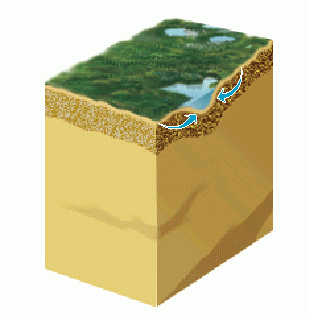 |
Lakes and wetlands in glacial and dune terrain can have inflow from ground water, outflow to ground water, or both (Figure 16). The interaction between lakes and wetlands and ground water is determined to a large extent by their position with respect to local and regional ground-water flow systems. A common conception is that lakes and wetlands that are present in topographically high areas recharge ground water, and that lakes and wetlands that are present in low areas receive discharge from ground water. However, lakes and wetlands underlain by deposits having low permeability can receive discharge from local ground-water flow systems even if they are located in a regional ground-water recharge area. Conversely, they can lose water to local ground-water flow systems even if they are located in a regional ground-water discharge area (Figure 24).
 |
Figure 24. In glacial and dune terrain, local, intermediate, and regional ground-water flow systems interact with lakes and wetlands. It is not uncommon for wetlands that recharge local ground-water flow systems to be present in lowlands and for wetlands that receive discharge from local ground water to be present in uplands.
Lakes and wetlands in glacial and dune terrain underlain by highly permeable deposits commonly have ground-water seepage into one side and seepage to ground water on the other side. This relation is relatively stable because the water-table gradient between surface-water bodies in this type of setting is relatively constant. However, the boundary between inflow to the lake or wetland and outflow from it, termed the hinge line, can move up and down along the shoreline. Movement of the hinge line between inflow and outflow is a result of the changing slope of the water table in response to changes in ground-water recharge in the adjacent uplands.
Dune terrain in Nebraska. (Photograph by James Swinehart.)
Transpiration directly from ground water has a significant effect on the interaction of lakes and wetlands with ground water in glacial and dune terrain. Transpiration from ground water (Figure 7) has perhaps a greater effect on lakes and wetlands underlain by low-permeability deposits than in any other landscape. The lateral movement of ground water in low-permeability deposits may not be fast enough to supply the quantity of water at the rate it is removed by transpiration, resulting in deep and steep-sided cones of depression. These cones of depression commonly are present around the perimeter of the lakes and wetlands (Figure 7 and Box K).
In the north-central United States, cycles in the balance between precipitation and evapotranspiration that range from 5 to 30 years can result in large changes in water levels, chemical concentrations, and major-ion water type of individual wetlands. In some settings, repeated cycling of water between the surface and subsurface in the same locale results in evaporative concentration of solutes and eventually in mineral precipitation in the subsurface. In addition, these dynamic hydrological and chemical conditions can cause significant changes in the types, number, and distribution of wetland plants and invertebrate animals within wetlands. These changing hydrological conditions that range from seasons to decades are an essential process for rejuvenating wetlands that provide ideal habitat and feeding conditions for migratory waterfowl.
"The hydrological and chemical characteristics of lakes and wetlands in glacial and dune terrain are determined to a large extent by their position with respect to local and regional ground-water flow systems"
Karst may be broadly defined as all landforms that are produced primarily by the dissolution of rocks, mainly limestone and dolomite. Karst terrains (area K of the conceptual landscape, Figure 2) are characterized by (1) closed surface depressions of various sizes and shapes known as sinkholes, (2) an underground drainage network that consists of solution openings that range in size from enlarged cracks in the rock to large caves, and (3) highly disrupted surface drainage systems, which relate directly to the unique character of the underground drainage system.
Big Spring, Missouri. (Photograph by James Barks.)
Dissolution of limestone and dolomite guides the initial development of fractures into solution holes that are diagnostic of karst terrain. Perhaps nowhere else is the complex interplay between hydrology and chemistry so important to changes in landform. Limestone and dolomite weather quickly, producing calcium and magnesium carbonate waters that are relatively high in ionic strength. The increasing size of solution holes allows higher ground-water flow rates across a greater surface area of exposed minerals, which stimulates the dissolution process further, eventually leading to development of caves. Development of karst terrain also involves biological processes. Microbial production of carbon dioxide in the soil affects the carbonate equilibrium of water as it recharges ground water, which then affects how much mineral dissolution will take place before solute equilibrium is reached.
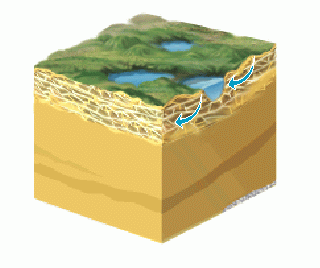 |
Ground-water recharge is very efficient in karst terrain because precipitation readily infiltrates through the rock openings that intersect the land surface. Water moves at greatly different rates through karst aquifers; it moves slowly through fine fractures and pores and rapidly through solution-enlarged fractures and conduits. As a result, the water discharging from many springs in karst terrain may be a combination of relatively slow-moving water draining from pores and rapidly moving storm-derived water. The slow-moving component tends to reflect the chemistry of the aquifer materials, and the more rapidly moving water associated with recent rainfall tends to reflect the chemical characteristics of precipitation and surface runoff.
Water movement in karst terrain is especially unpredictable because of the many paths ground water takes through the maze of fractures and solution openings in the rock (see Box L). Because of the large size of interconnected openings in well-developed karst systems, karst terrain can have true underground streams. These underground streams can have high rates of flow, in some places as great as rates of flow in surface streams. Furthermore, it is not unusual for medium-sized streams to disappear into the rock openings, thereby completely disrupting the surface drainage system, and to reappear at the surface at another place. Seeps and springs of all sizes are characteristic features of karst terrains. Springs having sufficiently large ground-water recharge areas commonly are the source of small- to medium-sized streams and constitute a large part of tributary flow to larger streams. In addition, the location where the streams emerge can change, depending on the spatial distribution of ground-water recharge in relation to individual precipitation events. Large spring inflows to streams in karst terrain contrast sharply with the generally more diffuse ground-water inflow characteristic of streams flowing across sand and gravel aquifers.
Stream disappearing into sinkhole in karst terrain in Texas. (Photograph by Jon Gilhousen.)
Because of the complex patterns of surface-water and ground-water flow in karst terrain, many studies have shown that surface-water drainage divides and ground-water drainage divides do not coincide. An extreme example is a stream that disappears in one surface-water basin and reappears in another basin. This situation complicates the identification of source areas for water and associated dissolved constituents, including contaminants, in karst terrain.
Water chemistry is widely used for studying the hydrology of karst aquifers. Extensive tracer studies (see Box G) and field mapping to locate points of recharge and discharge have been used to estimate the recharge areas of springs, rates of ground-water movement, and the water balance of aquifers. Variations in parameters such as temperature, hardness, calcium/magnesium ratios, and other chemical characteristics have been used to identify areas of ground-water recharge, differentiate rapid- and slow-moving ground-water flow paths, and compare springflow characteristics in different regions. Rapid transport of contaminants within karst aquifers and to springs has been documented in many locations. Because of the rapid movement of water in karst aquifers, water-quality problems that might be localized in other aquifer systems can become regional problems in karst systems.
Some landscapes considered to be karst terrain do not have carbonate rocks at the land surface. For example, in some areas of the southeastern United States, surficial deposits overlie carbonate rocks, resulting in a "mantled" karst terrain. Lakes and wetlands in mantled karst terrain interact with shallow ground water in a manner similar to that in sandy glacial and dune terrains. The difference between how lakes and wetlands interact with ground water in sandy glacial and dune terrain and how they interact in the mantled karst is related to the buried carbonate rocks. If dissolution of the buried carbonate rocks causes slumpage of an overlying confining bed, such that water can move freely through the confining bed, the lakes and wetlands also can be affected by changing hydraulic heads in the aquifers underlying the confining bed (see Box L).
Next--Effects of human activities on the interaction of ground water and surface water
Back to Introduction
Back to Contents